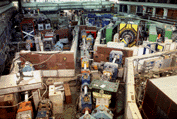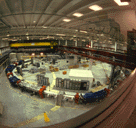

The Low Energy Antiproton Ring (LEAR)
LEAR: overview of the experimental area
The Antiproton Accumulator (AA) which has been transformed into the Antiproton Decelerator (AD) in 1999
From 1928 to 1995
1995: from
antiparticles to antimatter
After making antinuclei, naturally
the next question was: can antielectrons stick to antinuclei to make antiatoms?
In fact the answer was only revealed quite recently, thanks to a very special machine, unique to CERN, the Low Energy Antiproton Ring (LEAR). Contrary to an accelerator, LEAR actually "slowed down" antiprotons. Physicists could then try to force a positron (or antielectron) to stick to an antiproton, making an antihydrogen atom, a real antimatter atom.
Towards the end of 1995, the first such antiatoms were produced at CERN by a team of German and Italian physicists. Although only 9 antiatoms were made, the news was so thrilling that it made the front page of many of the world's newspapers.
The achievement suggested that the antihydrogen atom could play a role in the study of the antiworld similar to that played by the hydrogen atom in over more than a century of scientific history. Hydrogen makes up three quarters of our universe, and much of what we know about the cosmos has been discovered by studying ordinary hydrogen.
But does antihydrogen behave exactly like ordinary hydrogen ? To answer this question CERN decided to build a new experimental facility: the Antiproton Decelerator (AD).
|
(From
1928 to 1995 - page 5 of 5)
< Prev | |



